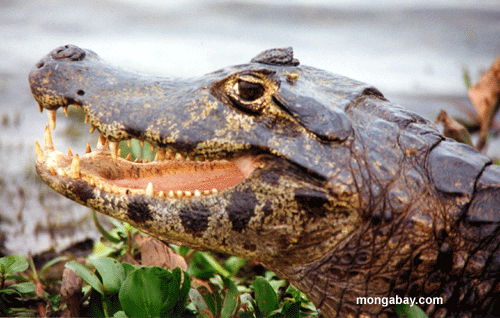Ancient 46-foot long crocodile found in Amazon
Rhett A. Butler, mongabay.com
September 3, 2005
 Caiman in the Brazilian Pantanal. Today the largest crocodilian (alligator or crocodile) found in South America is the Black Caiman, Melanosuchus niger which can approach 20 feet (6 m) in length. |
Peruvian scientists discovered the fossilized remains of a giant, 46-foot-(14-meter)-long crocodile deep in the Amazon rainforest, lending credence to a theory that the Amazon was once a huge inland sea.
The expedition, funded by the University of Toulouse and French clothing company Devanlay, made the discovery in northern Peru. The team estimates that the creature once weighed nine tons and had a 4-foot(1.3-meter)-long head.
Rodolfo Salas, head of paleontology at the National History Museum of Peru, told Reuters, “This rare find should help us prove that today’s Amazon jungle was once an inland sea, possibly connected to the Caribbean.”
History of the Amazon Rainforest
Scientists believe the Amazon River once flowed westward, perhaps as part of a proto-Congo (Zaire) river system from the interior of present day Africa when the continents were joined as part of Gondwana. Around fifteen million years ago, the collision of the South American plate with the Nazca plate created the Andes mountain range and blocked the flow of the Amazon, causing the river to become a vast inland sea. Gradually this inland sea became a massive swampy, freshwater lake and the marine inhabitants adapted to life in freshwater. For example, over 20 species of stingray, most closely related to those found in the Pacific Ocean, can be found today in the freshwaters of the Amazon.
Crocodile blood shows anti-HIV activity Scientists in Australia’s tropical north are collecting blood from crocodiles in the hope of developing a powerful antibiotic for humans, after tests showed that the reptile’s immune system kills the HIV virus. |
About ten million years ago, waters worked through the sandstone to the west and the Amazon began to flow eastward. At this time the Amazon rainforest was born. During the Ice Age, sea levels dropped and the great Amazon lake rapidly drained and became a river. Three million years later, the ocean level receded enough to expose the Central American isthmus and allow mass migration of mammal species between the Americas.
The Ice Ages caused tropical rainforest around the world to retreat. Although debated, it is believed that much of the Amazon reverted to savanna and montane forest (see chapter 3-Ice Ages and Glaciation). Savanna divided patches of rainforest into “islands” and separated existing species for periods long enough to allow genetic differentiation (a similar rainforest retreat took place in Africa. Delta core samples suggest that even the mighty Congo watershed was void of rainforest at this time). When the ice ages ended, the forest was again joined and the species that were once one had diverged significantly enough to be constitute designation as separate species, adding to the tremendous diversity of the region. About 6000 years ago, sea levels rose about 130 meters, once again causing the river to be inundated like a long, giant freshwater lake.
Today the Amazon rainforest houses around 30% of the species found on Earth.
This article used infomation from a Reuters news brief, “Peru finds giant crocodile fossil in Amazon” and from mongabay.com.